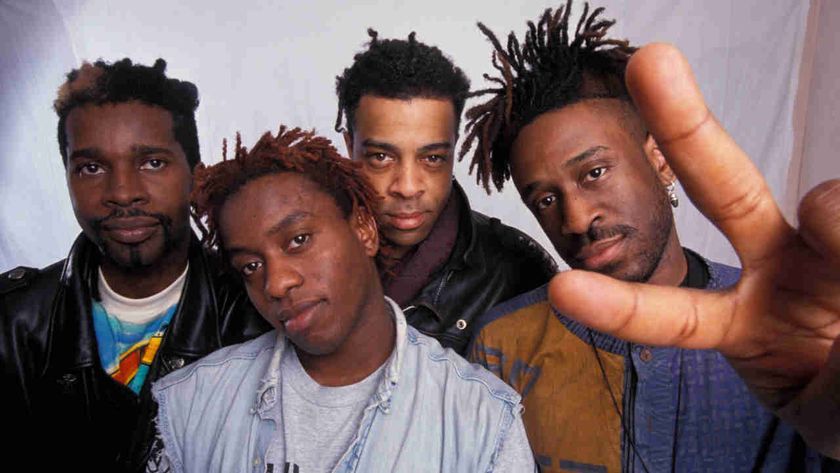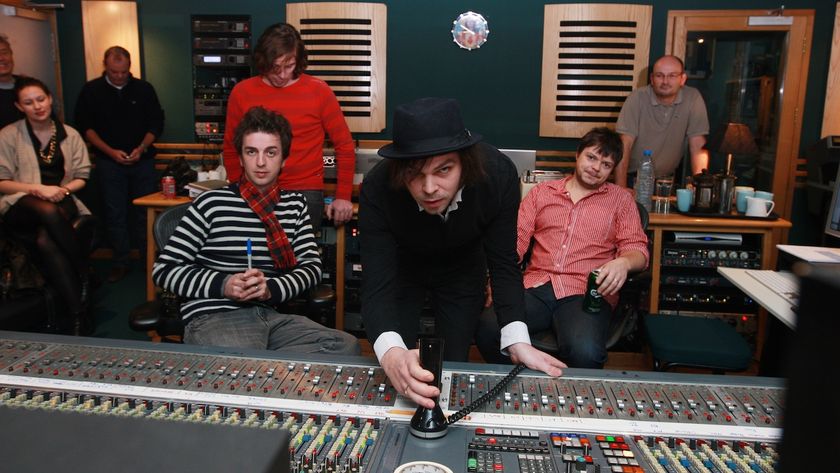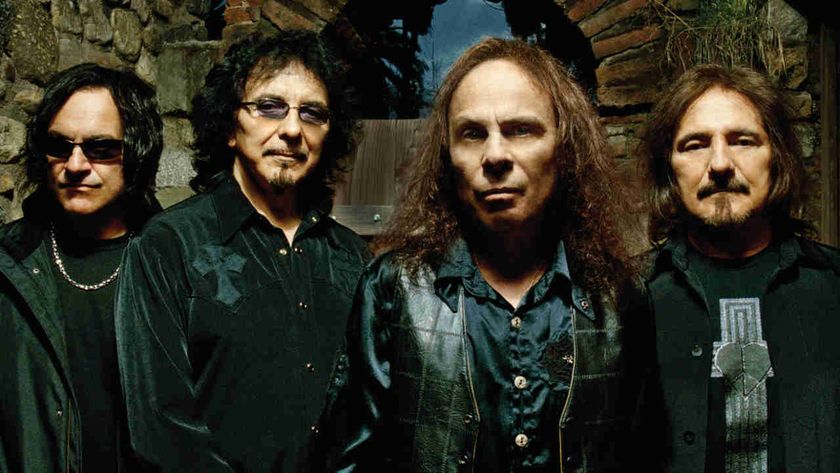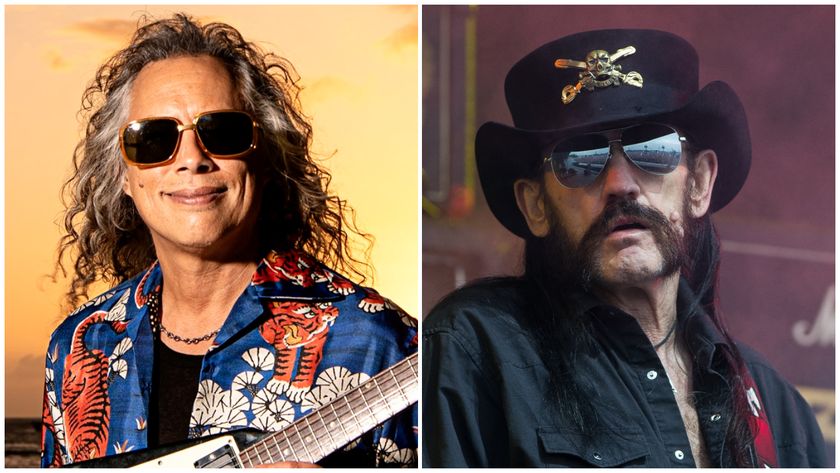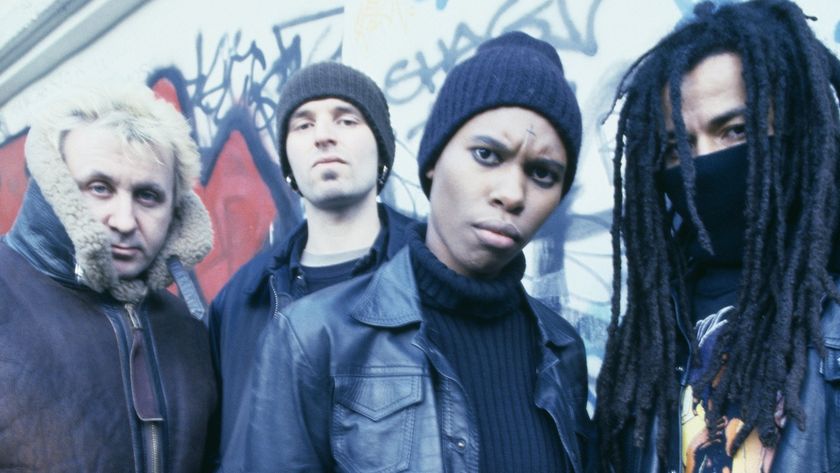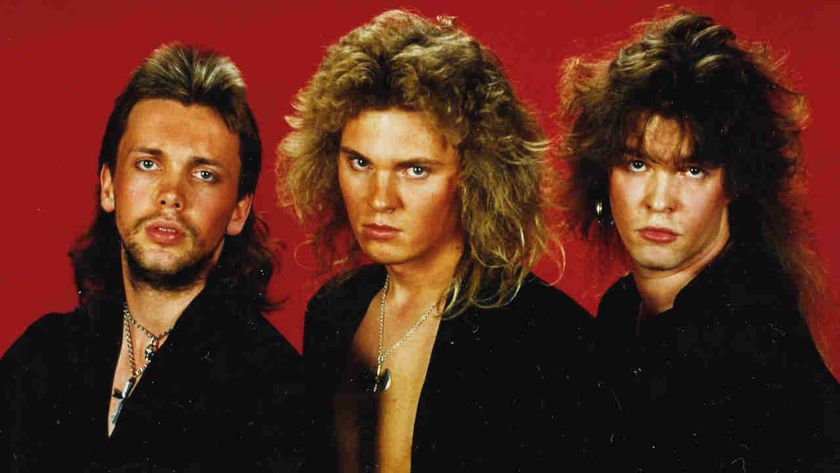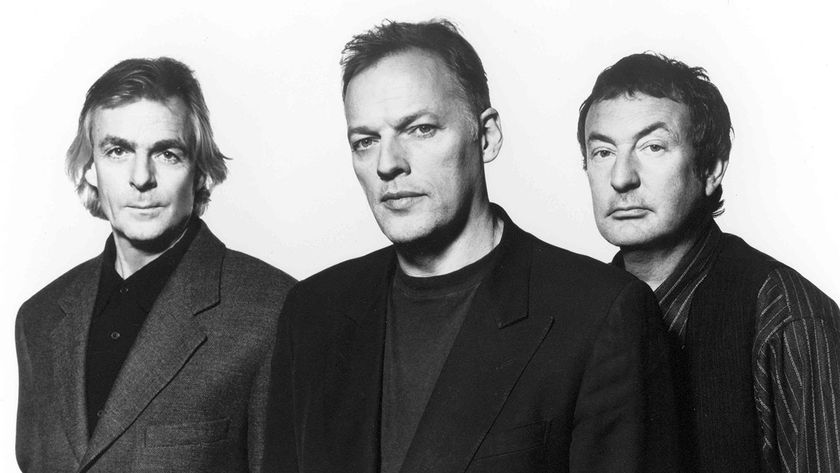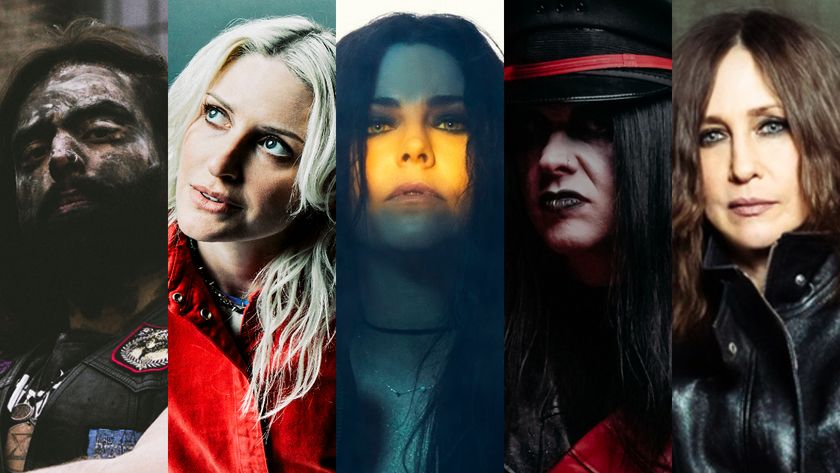20. Metallica – Kill ‘Em All
You can trust Louder Our experienced team has worked for some of the biggest brands in music. From testing headphones to reviewing albums, our experts aim to create reviews you can trust. Find out more about how we review.
During the May 1983 recording of Kill ’Em All, producer Paul Curcio interrupted a James Hetfield guitar take to tell Metallica’s frontman that the sound coming from his Marshall amp didn’t sound normal. “It’s not meant to sound normal,” Hetfield snarled.
Given that Curcio viewed Def Leppard’s recently released Pyromania album as a sonic reference point, his confusion is perhaps understandable. So ubiquitous has Metallica’s trademark guitar crunch become in the ensuing 33 years that it’s easy to forget just how harsh and discordant the San Franciscan band appeared at the outset of their career, when Hetfield and co-founder Lars Ulrich’s ambitions stretched little further than that they be recognised as the heaviest, fastest metal band in America.
This was originally to be titled Metal Up Your Ass, with a gory cover. “The label persuaded us that no record shop would stock it,” says drummer Lars Ulrich, “so we changed it – reluctantly.” Held within are thrash cornerstones Whiplash and Seek & Destroy. Metallica’s legend begins here.
19. Ritchie Blackmore’s Rainbow - Ritchie Blackmore’s Rainbow
Having quit Deep Purple when they got too funky for his taste, Ritchie Blackmore styled Rainbow as a more purist heavy rock band. Dio was a perfect foil, his richly expressive voice and fantasy imagery adding a mystical aura to the ‘castle rock’ archetypes Man On The Silver Mountain, The Temple Of The King and Sixteenth Century Greensleeves, the latter featuring his finest opening couplet: “It’s only been an hour/Since he locked her in the tower.” After years of toiling in obscurity, working with Blackmore was Dio’s first golden opportunity, and he seized it as if it were the Holy Grail itself. From there, he never looked back.
Freed from Deep Purple’s descent into funk, and buoyed by the vast vocal talent of Ronnie Dio, Ritchie Blackmore blazed brightly on this thrilling, epic opening salvo. This debut is all the more remarkable because Blackmore used members of Dio’s pre-Rainbow band, Elf, for the purpose of getting it into the shops. The sidemen were soon jettisoned, of course, but that doesn’t detract from the sheer quality of their performances.
18. Rush – Rush
This album broke the Canadian band in the US when the song Working Man resonated with the blue-collar workers of Cleveland – and jocks at local station WMMS realised the song was long enough for them to take a toilet break. The album inspired Gene Simmons to dub the band ‘Led Zeppelin Jr’. And, listening to the bluesy grooves of Finding My Way and In The Mood, it’s not difficult to see why.
“This was us trying to find a sound," says Geddy Lee. "Thinking we wanted to be a hard rock band and emulating those bands we thought were cool. I can hear Led Zeppelin in there, and a bit of Humble Pie. I wish I could hear more than just those influences, but I can’t. John Rutsey was very much a Simon Kirke kind of drummer – just hold down the backbeat and let’s rock out. So that’s how the songs came out.
“We recorded the album with a producer named David Stock, but it sounded so shitty we had to redo it with Terry Brown, who became our regular producer. With the second version we added a few more songs, and one of those was Finding My Way, which ended up being one of the most important tracks on the album – a real rocker.
“And the song that really got us noticed was Working Man. There was still radio in America at that time that wasn’t overly programmed, and DJs had the licence to play longer tracks. Working Man was seven minutes long, and the airplay it got led to us signing with Mercury Records. That one song had an incredible impact.”
17. Meat Loaf – Bat Out Of Hell
What began as a science-fiction update of Peter Pan morphed into West Side Story with a metal heartbeat. Written and conceived by Jim Steinman, sung by Meat Loaf, produced by Todd Rundgren, it’s now sold over 43 million copies worldwide, selling 200,000 copies every year. Rundgren summed it up: “I had to do this album. It’s so out there”.
The combination of whacked-out songwriter Steinman’s horny pocket symphonies and Meat’s leather-lunged operatic howl was unstoppable and untoppable. The hits will continue to resonate for the next thousand years. Your children’s children’s children will know all the words to Paradise By the Dashboard Light and Two of Three Ain’t Bad, I’m sure of it. Bat was created in a long-gone world where rock’n’roll gods stomped the Earth and no one stomped heavier than Meat Loaf. The term ‘classic rock’ was practically invented for this record.
16. Montrose - Montrose
Sammy Hagar once said of this album: “Everyone involved on the record label side made their mistakes with us, and then Van Halen benefited a few years later.” While Hagar had a point, this remains one of the greatest of all debuts from an US hard rock act – a blueprint for all the stadium-strutters who followed.
Before the release of Montrose’s self-titled debut, US hard rock played second fiddle to its British counterpart. But here was the sound of a band putting US hard rock and heavy metal squarely on the map. Guitarist Ronnie Montrose may have ostensibly been the star of the show, but this was the ideal launch pad for Hagar as both a singer and a songwriter. The frontman’s blazing Bad Motor Scooter became a staple of US radio – no small feat given that it was the first song he’d ever written. Throw in Space Station No. 5, Rock Candy and ebullient opener Rock The Nation and you’ve got one of the landmark rock records of the 70s.
15. Pearl Jam – Ten
Although Pearl Jam eventually rejected the mainstream, the band’s best album is also their most commercial: their magnificent debut, Ten. Instead of wallowing in misery following the demise of their band Mother Love Bone after the death of its singer, guitarist Stone Gossard and bassist Jeff Ament put together a much more back-to-basics band. In came Eddie Vedder on vocals, Mike McCready on guitar, Pearl Jam were born.
Disaffected youth was spoilt for choice in 1991. On Side A of the C90 tape in your oversized Walkman, the buzzsaw guitars and teen dispirit of Nirvana’s Nevermind; on Side B, Ten, the debut album by Seattle rivals Pearl Jam, with plenty to soundtrack the imagined woes of the teenage existence. Geography and timing ensured that both albums were lumped together as blueprints of the nascent grunge movement, but really the only common currency was the chuckle-free world-views of Kurt Cobain and Eddie Vedder (as the Nirvana frontman sneered at the time, Ten’s squall of guitar solos, arena-ready hooks and overt classic influences were hardly ‘alt’).
To listen to Ten in one sitting is an almost gluttonous pleasure, like eating too many chocolate liqueurs. It plays like a Greatest Hits and still sounds sufficiently huge. Once was always underrated, crashing in after the false start of the Master/Slave instrumental, but the opener is one of the album’s strongest tracks, built on a seething vocal and a snake-charmer riff. Vedder in character as a vengeful maniac with pedal to the floor and ‘sixteen-gauge buried under my clothes’. A song to make your neck bristle and your fists bunch, it announced Pearl Jam as a band to treasure, right out of the blocks.
Pearl Jam themselves seem to have a problem with Even Flow, generally agreeing that they flogged the spark out the original demo with too many takes (“Not sure why we didn’t use that one,” said original drummer Dave Krusen, “but I know it felt better”). For everyone else, the version that made it onto Ten was a belter, driven by that muscular-yet-snake-hipped riff, and managing to sing about homelessness without getting up your nose.
And, yes, while Alive’s riff may now be held as practically the alt.rock Layla, it’s still a stone-cold classic, from Gossard’s stadium-ready intro lick to Mike McCready’s spring-heeled solo (which he admits, incidentally, that he stole from Kiss’s She).
When Texas teenager Jeremy Wade Delle shot himself in front of his classmates on January 8th, 1991, the seed was planted for what remains arguably Vedder’s most powerful lyric. The blood-spattered MTV video was sensationalist, but the song is deathless, from Ament’s opening chimed harmonics to the bereft outro. Strange to think that Jeremy almost didn’t make the cut for Ten, the band struggling to balance the dynamics. “But this was an instance,” remembered Ament, “when persistence paid off.”
Those tracks are in good company, too: the honey-glazed verse of Black makes the bitter chorus land an even harder punch. Epic apparently badgered the band to release Black as the fourth single from Ten, but the line-up dug in their heels, helping the song to its enduring fan-favourite status. It’s a bit of an odd one, Black, alternating between rock’s most jaunty verse and most gut-wrenching chorus, but when Vedder delivers the devastating pay-off – ‘I know you’ll be a star in somebody else’s sky, but why can’t it be mine?’ – you’ll feel a cold shiver of recognition. Stunning.
But the best moments are the ones you’ve forgotten about: the ghostly chimes of, say, Garden, or the resigned beauty of Release, while Oceans remains undimmed in its woozy brilliance. The latter is a work of strange, glowering beauty, and gave Ten’s first indication that Pearl Jam could shift gears. They all lend a flavour to this spellbinding album, and confirm that Pearl Jam were too colourful to be painted with the plaid brush
14. Marillion – Script For A Jester’s Tear
The album that gave meaning to the rebirth of progressive rock. Upon their arrival on the rock scene, many felt that Marillion sounded too close to Peter Gabriel-era Genesis. “I think there was always a lot more to them than being another Genesis,” says producer Nick Tauber. And songs on their debut such as He Knows You Know and Garden Party definitely bear this out.
It was that anger that set Marillion apart from what had come before them, as well as their peers at the time. Discarding the whimsical window dressing of the previous generations, Fish’s lyrics veered between rage, frustration and heartbreak. The bleak, gloomy fanfare of The Web (‘The rain auditions at my window/Its symphonies echo in my head’) was a prog bedsit anthem; Chelsea Monday was the tale of a doomed rich girl, inspired by a newspaper headline Fish read on one of the amphetamine- fuelled early morning walks through London he had taken to going on; the lengthy, livid Forgotten Sons was ostensibly a protest song about the situation in Northern Ireland, though it could be read as a furious critique of the Thatcher government.
“I wasn’t the clichéd art-school person you normally expect in a prog band,” says Fish. “I wasn’t part of the Charterhouse squad. I was Scottish working in England. I felt a certain amount of isolation.”
13. The Doors – The Doors
Youth (Killing Joke): "One of the greatest debut albums by a rock group. What kind of band in 1966 would include a Kurt Weill/Bertolt Brecht song on their first album, or even start the first track with a bossa nova drum beat? The Doors were unique, then and now, mashing up Indian ragas with blues, jazz, rock, esoteric poetry and a phenomenal songwriting ability. Bottom line: they didn’t have any bad songs.
"Jim Morrison was the ultimate LSD shaman rock star: dark, poetic and moody; unpredictable and fearless; a sexualised psychedelic, shape-shifting Orphic space captain in the tradition of Fela Kuti, Sun Ra, Lee ‘Scratch’ Perry and other musical avatars of higher power consciousness.
"Sometimes they veered a little close to the edge of MOR, yet listen to the seven-minute extended version of Light My Fire as it subtly and effortlessly morphs into a trance-inducing cosmic freak-out. Ray Manzarek’s twisted fairground Vox Continental organ motif perfectly counterpoints Jim’s deadpan vocal delivery and the drums get more intense as they build into a Latin-flavoured voodoo stomp. The improvised guitar solo is a beautiful departure, eventually pulling back to the glorious pop chorus, subverted by what now sounds like a quite innocent, naïve if naughty, drug reference, but at the time was so controversial.
"The End does a similar thing, with an epic, 11-minute catapult into The Heart Of Darkness, a seductive and hypnotic dronelike raga of organ and guitars, a psychedelic hymn and possibly their finest moment. The album opens with an urgent and intense Break On Through (To The Other Side). It’s the anthem for every mushroom stonerhead, concerning every budding bedroom astronaut’s ambition, the soundtrack to psychedelic transcendency… potentially."
12. Dio – Holy Diver
After leaving Black Sabbath, Ronnie James Dio was determined to go his own way. “I wanted to be in charge of my career,” he said. So the singer formed Dio, debuting with this memorable album.
One of the classic heavy metal debuts, Holy Diver is a work of such bravura and bombast that Sounds magazine stated emphatically: “Ronnie James Dio has thundered back.” This was a new beginning for Ronnie, but his past was in evidence both in his choice of two former bandmates (ex Rainbow bassist Jimmy Bain, ex-Sabbath drummer Vinny Appice) and in the epic feel of the music.
The little fella’s masterstroke was the acquisition of 19-year-old guitarist Vivian Campbell, the man who “put the fast in Belfast”, who gave the band a vital, contemporary edge. Every song was impressive, and guitarist Vivian Campbell was an inspired choice. “I love what he did here,” Dio said at the time.
With its electrifying opener Stand Up And Shout, its spooky title track and the majestic Rainbow In The Dark, Holy Diver was the album on which Dio, the man, was able to fully realise his own singular vision. The title track, Stand Up And Shout and Rainbow In The Dark remain true metal classics.
11. Jimi Hendrix – Are You Experienced?
When Jimi Hendrix landed on British soil and formed the Jimi Hendrix Experience in 1966 he may as well have been beamed down directly from a spaceship en route to Mars. Instead he had been coaxed over from his life as a struggling New York backing musician by former Animals bassist Chas Chandler. And Jimi’s guitar-playing skills were truly other-worldly. Yes, there were plenty of tasty guitarists around in the mid-60s, but no one could hold a candle to Hendrix. On his debut album Are You Experienced in 1967 we were given so many ground-breaking gifts.
What Hendrix managed to do with his guitar, the sounds he occasionally teased, often thrashed out of that lump of wood with strings attached, put him in a league of his own. From screeching feedback to delicious dollops of wah-wah, his tone was an absolute bolt from the blue. Then there were his solos. A guitar solo was no longer a means of getting from the bridge to the final chorus, instead Hendrix’s solos were moments full of colour. When he was in the mood it sounded like his fingers were about to burst into flames.
But Are You Experienced isn’t a guitar-chops wankathon, it’s packed full of killer songs. Not just great songs, but daringly innovative material. There’s the guitar attack of Foxy Lady, Fire with its bonkers, off-the-wall funk feel, and, on the original US release, stripped-back ballads such as The Wind Cries Mary. This record showed Hendrix as a thoughtful, soulful songwriter as well as a smokin’ riff master.
Are You Experienced put this Seattle kid on the map as the greatest guitarist of his time, and one of the most iconic rock stars the world had ever seen, both of which still ring true today. If that’s not a legacy, we don’t know what is.


